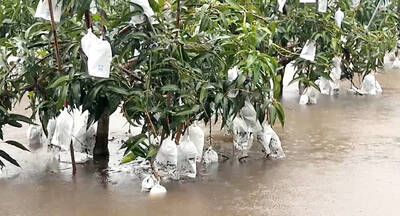After a freak dust storm covered the nation last April, Kaohsiung resident Chan Chia-chun (詹家駿) began donning a mask before riding his scooter to a nearby marketplace every morning.
The windblown dust storms that originate in the deserts of China and make their way to Taiwan every spring are widely blamed for sore throats, skin problems and respiratory failure, health experts say.
The dust storms have become such a problem that the Environmental Protection Administration (EPA) set up a monitoring Web site last November to track them and give members of the public a look at long-term trends.

PHOTO: YU TAI-LANG, TAIPEI TIMES
However, dust storms are not only becoming an increasingly potent — and uncontrollable — problem from abroad. In Taiwan itself, dry river beds and diminishing riverside forests are also leading to a gradual increase in the frequency and force of dust storms whipped up locally, experts say.
Parts of Taisi (台西) and Lunbei (崙背) townships in Yunlin County were coated last November by a dust storm that EPA monitoring stations found contained particle densities between 1,000 and 2,500 micrograms per square meter, which far exceeded standards set by health authorities.
They deem densities above 150 to be detrimental to human health and amounts above 420 to be dangerous.
It has become such a problem, especially in recent years, that some townships advise elementary school students to stay home sometimes between November and March when prevailing northeast winds blow loose sand from dry riverbeds, creating dust storms.
The trouble is especially noticeable in central Taiwan along the Da-an (大安溪), Dajia (大甲溪) and Jhuoshuei (濁水溪) rivers, as well as in Taitung County beside the Beinan River (卑南溪) because of its drier climate and changes to water flow patterns caused by Typhoon Morakot last August, researchers say.
Lawmakers have been trying, some say unsuccessfully, to rectify the problem.
During the last legislative session, Democratic Progressive Party Legislator Liu Chien-kuo (劉建國) proposed an amendment to the Disaster Prevention and Protection Act (災害防救法) to add dust storms to the list of “natural” disasters. Legislators have also tried to introduce subsidies for crop damage caused by the storms.
Many of these efforts are trying to mitigate the issue, not solve the root causes, researchers said. They said that to tackle the problem, solutions have to reach below the ground — to a lack of foliage and dwindling water supplies.
“It’s a complicated problem,” said Yeh Chi-hui (葉啟輝), a professor of environmental engineering at Da Yeh University. “There are many factors involved … and for many of [them], not a lot of data has been gathered.”
Data from Yunlin County’s Environmental Bureau shows the frequency of dust storms has been slowly increasing over the past few years, but many researchers said there have not been enough government studies into the causes and effects of the dust storms.
Yeh said many farmers and local officials do not realize that the problem is growing, despite the statistics showing the increase.
Many farmers continue to grow their watermelon crops beside rivers — some legally, others illegally — causing uplifted and loose soil, especially before planting season in January and February.
Deforestation is another major issue as forests have gradually been cut back to make room for agricultural plantations, reducing wind cover and allowing larger gusts to pick up loose soil particles, Yeh said.
Then there are the water problems. Less water has been flowing into riverbanks, which results in more uncovered riverbeds, leaving more soil vulnerable to wind gusts, Yeh said.
Some local politicians and farming associations have long blamed big factories for the lack of water and receding river levels.
These are problems that will have to be dealt with quickly as the dust particles contain heavy amounts of metals and minerals, which can quickly damage the human body, said Kuo Chung-yih (郭崇義), a professor at Chung Shan Medical University who specializes in environmental science.
Kuo’s research has found that long-term exposure to larger particles of 10 micrometers or less in diameter could result in breathing and liver problems and could later lead to heart and artery complications.
The danger is clear, he said, but “nobody has fixed the problem.”
There are some encouraging signs.
Officials at a public hearing at the legislature late last month promised to study the possibility of providing free health checks for everyone living near four rivers in Yunlin, Taichung and Taitung counties.
The results would be used to evaluate the local dust storm problem and could be used to jumpstart initiatives to rectify the problem.
Environmental Protection Administration Minister Stephen Shen (沈世宏) has assigned a task force to evaluate the problem.
“In the agency’s view… fixing this problem would be even more important to health checks … We are going to do our best to look for solutions,” Shen told the hearing.
Air Quality Protection and Noise Control head Hsieh Yen-ju (謝燕儒) said environmental officials would work with local governments to plant more foliage in riverbank areas and increase the number of monitoring stations.
Some critics said the EPA is taking a Band-Aid approach to solving the problem, but others were more optimistic.
Local officials and county councilors said after the hearing they were glad the government was willing to address the problem and that many of their constituents could finally breathe a sigh of relief.

‘NON-RED’: Taiwan and Ireland should work together to foster a values-driven, democratic economic system, leveraging their complementary industries, Lai said President William Lai (賴清德) yesterday expressed hopes for closer ties between Taiwan and Ireland, and that both countries could collaborate to create a values-driven, democracy-centered economic system. He made the remarks while meeting with an Irish cross-party parliamentary delegation visiting Taiwan. The delegation, led by John McGuinness, deputy speaker of the Irish house of representatives, known as the Dail, includes Irish lawmakers Malcolm Byrne, Barry Ward, Ken O’Flynn and Teresa Costello. McGuinness, who chairs the Ireland-Taiwan Parliamentary Friendship Association, is a friend of Taiwan, and under his leadership, the association’s influence has grown over the past few years, Lai said. Ireland is

A saleswoman, surnamed Chen (陳), earlier this month was handed an 18-month prison term for embezzling more than 2,000 pairs of shoes while working at a department store in Tainan. The Tainan District Court convicted Chen of embezzlement in a ruling on July 7, sentencing her to prison for illegally profiting NT$7.32 million (US$248,929) at the expense of her employer. Chen was also given the opportunity to reach a financial settlement, but she declined. Chen was responsible for the sales counter of Nike shoes at Tainan’s Shinkong Mitsukoshi Zhongshan branch, where she had been employed since October 2019. She had previously worked

FINAL COUNTDOWN: About 50,000 attended a pro-recall rally yesterday, while the KMT and the TPP plan to rally against the recall votes today Democracy activists, together with arts and education representatives, yesterday organized a motorcade, while thousands gathered on Ketagalan Boulevard in Taipei in the evening in support of tomorrow’s recall votes. Recall votes for 24 Chinese Nationalist Party (KMT) lawmakers and suspended Hsinchu City mayor Ann Kao (高虹安) are to be held tomorrow, while recall votes for seven other KMT lawmakers are scheduled for Aug. 23. The afternoon motorcade was led by the Spring Breeze Culture and Arts Foundation, the Tyzen Hsiao Foundation and the Friends of Lee Teng-hui Association, and was joined by delegates from the Taiwan Statebuilding Party and the Taiwan Solidarity

TRANSPORT DISRUPTION: More than 100 ferry services were suspended due to rough seas and strong winds, and eight domestic flights were canceled, the ministry said Tropical Storm Wipha intensified slightly yesterday as it passed closest to Taiwan, dumping more than 200mm of rain in Hualien and Taitung counties, the Central Weather Administration (CWA) said. As of 11am, Wipha was about 210km southwest of Cape Oluanpi (鵝鑾鼻) and was moving west-northwest at 27km per hour (kph). The storm carried maximum sustained winds of 101kph and gusts reaching 126kph, with a 150km radius of strong winds, CWA data showed. Wipha’s outer rainbands began sweeping across Taiwan early yesterday, delivering steady rainfall in the east and scattered showers in other regions, forecasters said. More heavy rain was expected, especially in the eastern